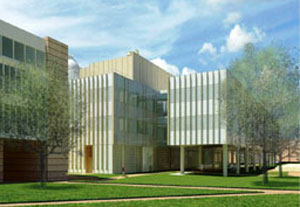| Mar 25, 2011 |
Rice University unveils state-of-the-art physics research facility
|
|
(Nanowerk News) Officials from Rice University and the U.S. Department of Commerce today dedicated Brockman Hall for Physics, a state-of-the-art research facility that is the new home for fundamental and applied physics research at Rice. The 111,000-square-foot, four-story building was partially funded by $11.1 million in federal stimulus funding from the National Institute of Standards and Technology (NIST).
|
 |
| Brockman Hall for Physics.
|
|
"Brockman Hall enhances Rice's status as one of the nation's premier research universities, and it ensures that Ricewill remain a leader in fundamental and applied physics research for years to come," said Rice President David Leebron. "The impact of Brockman Hall goes beyond bricks and mortar. This facility forges new pathways between science and engineering, between theory and practice and between Rice's first and second centuries."
|
|
Special guests at the building's dedication ceremony included Patrick Gallagher, undersecretary of commerce for science and technology and NIST director; Robert Celotta, director of NIST's Center for Nanoscale Science and Technology; and Shannon Walker, NASA astronaut and Rice alumna.
|
|
Rice faculty and staff began moving into Brockman Hall last month. When fully occupied in June, the building will be home to dozens of experimental, theoretical and applied physicists from Rice's departments of Physics and Astronomy and of Electrical and Computer Engineering. Brockman Hall will support research in atomic, molecular and optical physics; biophysics; condensed matter physics; nanoengineering and photonics.
|
|
The facility is special forseveral reasons: It was designed, constructed and occupied in just 33 months; it brings together faculty and students who formerly worked in five separate buildings scattered broadly across the campus; it is both a carefully refined 21st-century research facility and one of the most environmentally sustainable buildings at Rice; and it maintains much of the outdoor space that previously existed on Rice's Science Quadrangle.
|
|
Brockman Hall is composed of two parallel, rectilinear, spatial "bars" that are oriented east to west and connected by glass-enclosed bridges across an open passage that admits natural light and outdoor breezes. The larger south bar houses laboratories, faculty and research offices, a 150-seat lecture hall and a rooftop astronomical observatory. The elevated two-story north bar houses faculty, student and departmental offices and meeting spaces.
|
|
The open space beneath the north bar is framed by a "loggia" of tapered concrete columns that form an outdoor room, with shaded areas for class meetings, casual gathering and circulation. Beneath this serene outdoor oasis lies a sensitive and sophisticated complex of laboratories. Designed for vibration-sensitive atomic, molecular and optical physics and condensed-matter research, the hermetically controlled basement laboratories are stabilized on a two-foot-deep concreteslab and isolated from all the building's mechanical systems. State-of-the-art equipment supplies these labs with "clean" electrical power, chilled water and filtered air that is cleansed of submicroscopic dust.
|
|
One of the primary challenges faced by architect KieranTimberlake Associates was to provide such specialized and sophisticated research facilities within a context that could meet the U.S. Green Building Council's standards for Leadership in Energy and Environmental Design (LEED). KieranTimberlake's clever and elegant design met LEED Silver standards, and thanks to the tireless efforts of Rice's Facilities, Engineering and Planning Department and to the attention to detail by construction contractor Gilbane Building Company, Brockman is expected to contend for LEED Gold status.
|
|
Energy-saving and environmental features of the building include an energy-recovery system -- the largest in a single air unit in Texas -- that will save as much as 30 percent of the energy needed to cool the building in the summer. Another green innovation is the building's de-humidification system, which turns Houston's legendary humidity into an asset by capturing and returning 100,000 gallons of pure, clean water to Rice's central plant each year.
|
|
"This is a remarkable building in every sense, and it complements the excellent work of the physics community at Rice University," said Dan Carson, dean of Rice's Wiess School of Natural Sciences. "The future for science is extremely bright, and Brockman Hall is a clear demonstration of Rice's commitment to scholarship and achievement in the physical sciences."
|

